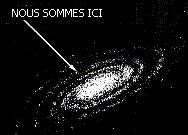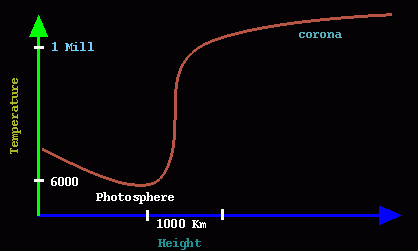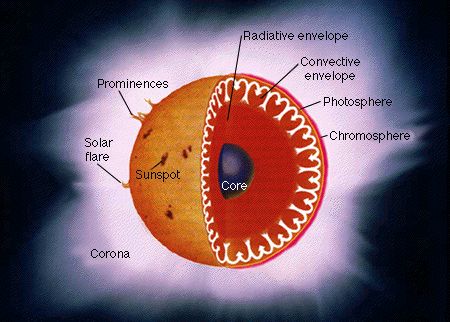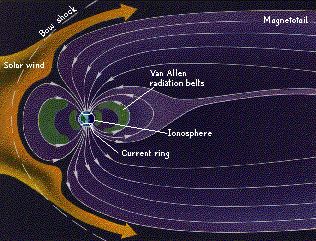soleil 1
Le Soleil est décrit comme une petite étoile parmi les 200 milliards qui composent notre Galaxie (G majuscule, car il s'agit de notre galaxie, la Voie Lactée). Situé sur l'un des bras extérieurs , aux 3/5 du centre (27 000 années-lumière ) , il se manifeste à nous par sa luminosité et par la chaleur qu'il nous envoie.
C'est une étoile de génération ultérieure, c'est-à-dire qu'elle est née au sein d'un milieu enrichi des éléments lourds issus des étoiles précédentes. Ce n'est pas une étoile primordiale, née à partir les éléments primordiaux, nés tout de suite après le Big bang, que sont l'hydrogène, l'hélium, lithium, bore et béryllium. Les éléments tels le carbone, l'azote, l'oxygène, le fer, le silicium, etc... que contient le Soleil, furent synthétisés dans les étoiles des générations précédentes, soit pendant toute leur vie, soit à leur mort (supernova)
. 
Grâce à lui, notre connaissance sur les étoiles progresse beaucoup plus vite . C' est la seule étoile que nous puissions approcher. La suivante immédiate, Proxima du Centaure 4,22 al ( 30 milles milliards de km) . C'est un système de 3 étoiles dans le Centaure, visible dans l'hémisphère sud. Lorsque l' on songe au fait, que les sondes, qui filent dans l'espace à 16 km/s ( grâce à la réaction de gravitation de Jupiter ) , ont parcouru 7 milliards de km en 25 ans, cela donne une idée de la distance de notre voisine. Il y a un rapport de 4000.
www.freinet.org/.../ cm/2001/exposes/soleil.htm
 |
Le Soleil est né y a 5 milliards
d'années. Quand il mourra il va faire exploser Mercure et Vénus et il sera mort. Il disparaîtra dans 5 milliards d'années. |
 |
Son diamètre et de 1 400 000 KM (108 fois plus large que la Terre). Le diamètre de la Terre est de 12 000 KM. Le Soleil n'est qu'une étoile assez petite parmi les milliards d'étoiles qui nous environnent ; les plus grosses étoiles peuvent être jusqu'à 1000 fois plus grosses. Les plus petites étoiles peuvent fois moins grosses. La température au centre du soleil est de 10 à 15 millions de degrés, température suffisante pour que la fusion nucléaire soit possible. L'hydrogène peut se transformer alors en hélium. |




Here is a diagram of the Sun, showing its insides aswell as its atmosphere. In this section, we concentrate on how to model some of the strange phenomena seen on the Sun. Three different parts of the solar atmosphere are pointed out; the solar surface, photosphere , the chromosphere , and the corona .
When astronomers discovered that the temperature in the solar atmosphere rises rapidly as the distance from the solar surface increases, they were amazed. Observations have provided us with measurements of how the temperature changes as you go higher in the solar atmosphere. This is shown in the illustration below.

Until recently we did not understand why the outer part of the solar atmosphere (the corona) is so hot, but we now have several clues to help us discover what is happening.
- All energy from the sun is produced in the solar core - far below the solar atmosphere. The temperature in the centre of the Sun is around 16,000,000 degrees. We would naturally expect the temperature to decrease as the distance from the center of the Sun increases.
- The laws of physics suggest that energy from a gas of a given temperature cannot normally be used to heat another gas to a higher temperature.
Take the example of a radiator or fireplace in your house. At nightime, the room never gets hotter that the radiator or fire, and the further away you are the cooler it gets. Of course, in the daytime, the Sun may be shining in through the windows and giving extra warmth to the room.
The situation in the solar atmosphere should be very similar. However, the temperature does not continue to decrease with height! Somehow the corona is heated a lot and the natural question is therefore:
How does the energy get into the corona? The physics of balloons and rubber bands.
The convection stops at the photosphere. This kinetic energy can therefore not be carried directly up into the corona to heat it. So how does the sun carry the energy up into its atmosphere?
The image on the right shows loop structures in the Solar atmosphere. From observations we have discovered that the loop structures found in the solar corona are defined by a magnetic field.
The air around us is made up of neutral atoms and in physics we call this a neutral gas. As the temperature of the gas is increased the electrons of the atoms start to be stripped away from the nuclei creating a gas of ions, which we call a plasma . This plasma can carry currents and magnetic fields .
In the picture above there are magnetic fields coming out of the photosphere, rising up into the corona and then connecting back down through into the photosphere again. These form the loop structures. It is not the magnetic field that we see in the image, but the radiation from the plasma trapped by the magnetic field lines. The physics shows that plasma trapped on a magnetic field line stays on that field line. The magnetic field is therefore the link that we need to carry the energy from the convective motions up into the corona.
But how does this energy transport work?
We all know that it is not possible to heat up a room mixing in cold air, for example by opening a window in winter! So, how does the magnetic field change this concept?
Some of the effects of a magnetic field line can be illustrated by a rubber band! A rubber band is an elastic string, which can be stretched, twisted and wound up. These basic characteristics are also true for a magnetic field and can be used to explain how the energy iscarried into the corona.
Let's return to the rice pudding again and take the model further. The physical differences between the photosphere and the corona are to some extend comparable to the difference between the rice pudding and the air just above it. In both cases the density changes enormously over the same short distance where the temperature changes. However, in the case of the Sun, the temperature jumps from a lower to a higher value as you go up from the dense photosphere to the less dense corona.
The convective motions below the photosphere move the magnetic field around with it - first the end of the field line is dragged in one direction and then in another. Because the corona is much less dense than the photosphere, the magnetic field drags the coronal plasma along with it as the ends of the magnetic fieldline are being forced to move around by the convective motions in the photosphere.
You can get an idea of the effect by taking a balloon and using a rubber band as the string attached to it. Take the rubber band in your hand and move your hand around. If your hand is moving slowly from side to side then the balloon will follow the motions. However, if you make short fast movements with you hand then the string will move and the balloon will only tip from side to side.

The Core
The innermost layer of the sun is the core. With a density of 160 g/cm^3, 10 times that of lead, the core might be expected to be solid. However, the core's temperature of 15 million kelvins (27 million degrees Fahrenheit) keeps it in a gaseous state.
In the core, fusion reactions produce energy in the form of gamma rays and neutrinos. Gamma rays are photons with high energy and high frequency. The gamma rays are absorbed and re-emitted by many atoms on their journey from the envelope to the outside of the sun. When the gamma rays leave atoms, their average energy is reduced. However, the first law of thermodynamics (which states that energy can neither be created nor be destroyed) plays a role and the number of photons increases. Each high-energy gamma ray that leaves the solar envelope will eventually become a thousand low-energy photons.

The neutrinos are extremely nonreactive. To stop a typical neutrino, one would have to send it through a light-year of lead! Several experiments are being performed to measure the neutrino output from the sun. Chemicals containing elements with which neutrinos react are put in large pools in mines, and the neutrinos' passage through the pools can be measured by the rare changes they cause in the nuclei in the pools. For example, perchloroethane contains some isotopes of chlorine with 37 particles in the nucleus (17 protons, 20 neutrons). These Cl-37 molecules can take in neutrinos and become radioactive Ar-37 (18 protons, 19 neutrons). From the amount of argon present, the number of neutrinos can be calculated.
2Envelope
Outside of the core is the radiative envelope, which is surrounded by the convective envelope. The temperature is 4 million kelvins (7 million degrees F). The density of the solar envelope is much less than that of the core. The core contains 40 percent of the sun's mass in 10 percent of the volume, while the solar envelope has 60 percent of the mass in 90 percent of the volume.
The solar envelope puts pressure on the core and maintains the core's temperature.
The hotter a gas is, the more transparent it is. The solar envelope is cooler and more opaque than the core. It becomes less efficient for energy to move by radiation, and heat energy starts to build up at the outside of the radiative zone. The energy begins to move by convection, in huge cells of circulating gas several hundred kilometers in diameter. Convection cells nearer to the outside are smaller than the inner cells. The top of each cell is called a granule. Seen through a telescope, granules look like tiny specks of light. Variations in the velocity of particles in granules cause slight wavelength changes in the spectra emitted by the sun.
"Convective cells are arranged in tiers containing cells of progressively smaller size as the surface is neared. This is still a highly simplified diagram, however. There are many different cell sizes, and they are not so neatly arranged." (369, Chaisson )
4Photosphere
The photosphere is the zone from which the sunlight we see is emitted. The photosphere is a comparatively thin layer of low pressure gasses surrounding the envelope. It is only a few hundred kilometers thick, with a temperature of 6000 K. The composition, temperature, and pressure of the photosphere are revealed by the spectrum of sunlight. In fact, helium was discovered in 1896 by William Ramsey, when in analyzing the solar spectrum he found features that did not belong to any gas known on earth. The newly-discovered gas was named helium in honor of Helios, the mythological Greek god of the sun.
6Chromosphere
In an eclipse, a red circle around the outside of the sun can sometimes can be seen. This is the chromosphere. Its red coloring is caused by the abundance of hydrogen.
From the center of the sun to the chromosphere, the temperature decreases proportionally as the distance from the core increases. The chromosphere's temperature, however, is 7000 K, hotter than that of the photosphere. Temperatures continue to increase through the corona.
4.Sunspots
Sunspots are dark spots on the photosphere, typically with the same diameter as the Earth. They have cooler temperatures than the photosphere. The center of a spot, the umbra, looks dark gray if heavily filtered and is only 4500 K (as compared to the photosphere at 6000K). Around it is the penumbra, which looks lighter gray (if filtered). Sunspots come in cycles, increasing sharply (in numbers) and then decreasing sharply. The period of this solar cycle is about 11 years.
The sun has enormous organized magnetic fields that reach from pole to pole. Loops of the magnetic field oppose convection in the convective envelope and stop the flow of energy to the surface. This results in cool spots at the surface which produce less light than the warmer areas. These cool, dark spots are the sunspots.
Corona
The outermost layer of the sun is the corona. Only visible during eclipses, it is a low density cloud of plasma with higher transparency than the inner layers. The white corona is a million times less bright than the inner layers of the sun, but is many times larger.
The corona is hotter than some of the inner layers. Its average temperature is 1 million K (2 million degrees F) but in some places it can reach 3 million K (5 million degrees F).
Temperatures steadily decrease as we move farther away from the core, but after the photosphere they begin to rise again. There are several theories that explain this, but none have been proven.
The picture of the sun that looks smooth (above) was taken with heavily filtered visible light. The picture showing more turbulence (below) was taken with x rays. The heat and energy of the corona cause the emission of x rays
2Flares
In the corona, above sunspots and areas of complex magnetic field patterns, are solar flares. These sparks of energy sometimes reach the size of the Earth and can last for up to several hours. Their temperature has been recorded at 11 million K (20 million degrees F). The extreme heat produces x rays that create light when they hit the gasses of the corona.
1Prominences
Prominences are generally less violent than solar flares. They are "cool sheets of gas that condense out of the corona above the active regions. Some are quiet and hang there for weeks, others rain matter down on the photosphere, still others literally explode into space, pushing the corona out in front of them in a great burst that carries the gas off the sun altogether." (113, Kaler )
Wind
The solar corona is constantly losing particles. Protons and electrons evaporate off the sun, and reach the earth at velocities of 500 km/s. Most of the mass of the sun is held in by magnetic fields in the corona, but particles slip through occasional holes in the fields. Solar wind affects the magnetic fields of all the planets in the solar system. When the solar wind hits the Earth's magnetic field, the wind compresses the field and creates a shock wave called the Bow shock. Closer to the Earth are the Van Allen radiation belts where solar particles are trapped due to magnetic forces. Still closer are huge rings of electric current around the poles, formed by the influence of the solar wind on the magnetic field. Earth, Jupiter, Saturn, Uranus, and Neptune have magnetotails where the wind extends their magnetic field.
The heliopause is the boundary where the sun's solar wind hits the gasses of interstellar space. The sun's particles flow at least to Neptune, and probably farther. That means that we're inside the sun!

La force de gravitation ou pesanteur s'élève à 274 m.s² (9,81m.s²) , d'où une vitesse de libération , nécessaire pour s'arracher de sa surface, de 617,6 km/s contre 8 km/s sur Terre. Et, dans la 1ère seconde de chute sur le soleil, un objet, non volatilisé, parcourt 137 m et sa vitesse passe de 0 à 986 km/h. Sur Terre, au cours de sa 1ère seconde de chute, un corps parcourt 4,9 m et sa vitesse est alors de 35, 3 km/h.
Il exerce sur nous une force de 42 g ( pour un homme de 70 kg ) et 300 T sur un pétrolier de 500 000 T. Il nous attire et donc nous allége.
Il exerce aussi, une force de 3,8.10 21 kg-force permettant à Saturne d'être maintenue sur son orbite.
Cette force permet aussi à la Terre d'être maintenue sur son orbite, comme tous les astres. Cette force s'appelle Attraction Universelle :
Il en est de même avec l'étoile de Bételgeuse , qui est une géante dont la masse est 16 fois le Soleil (3,13.10 31 kg) et le diamètre 800 fois celui-ci (taille de l'orbite de Jupiter ). Elle est située à 520 al de nous, dans la constellation d'Orion , et le Soleil exerce une force 17,3 milliards de tonnes-force sur elle. Réciproquement, le Soleil subit la même force de la part de Bételgeuse ( principe de l'action et de la réaction de Newton ). Attention à ne pas se laisser influencer par les chiffres, car le Soleil à une action 200 millions de fois plus forte sur nous. Quant à la Lune, elle exerce sur nous, une force d'attraction 170 fois plus faible que celle du Soleil, mais 1 000 000 fois plus forte que celle de Bételgeuse.
N'oublions pas les effets causés par la planète Jupiter sur son satellite Io .
 www.corradi.be
www.corradi.be
 calendrier
calendrier
 motos Clubs organisation
motos Clubs organisation
 mushing
mushing
 nature Gendarmerie
nature Gendarmerie
.png) liens annonceurs
liens annonceurs












